Coronavirus: How lockdown is being lifted across Europe
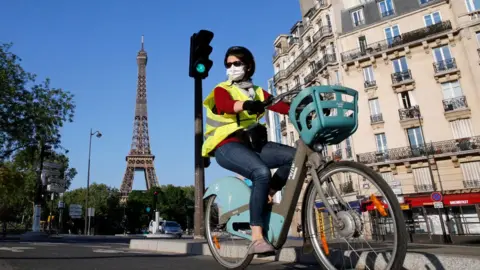 Getty Images
Getty ImagesAcross Europe, lockdown measures are being lifted cautiously, in phases.
Businesses are reopening and many children are back in school. Many of Europe's internal borders opened again in mid-June. Then the EU lifted external borders to some nations on 1 July, although member states can choose not to allow in travellers from these countries.
Here is how Europeans are emerging from life under lockdown.

Germany: Opening up with 'emergency brake'
 Reuters
ReutersGermany began reopening smaller shops in April: in early May control of lifting the lockdown was handed to the 16 federal states.
However, Chancellor Angela Merkel stressed that an ''emergency brake'' would be applied anywhere with a surge in new infections. A surge in cases linked to a meat processing plant near the town of Gütersloh caused regional authorities to reimpose local lockdowns on 23 June.
Foreign minister Heiko Maas lifted a travel ban for EU member states and specified European countries including the UK.
- Bundesliga football matches resumed behind closed doors on 16 May - the first big European league to do so
- Shops of all sizes have reopened with extra hygiene and social distancing
- Shops smaller than 800 sq m were allowed to open from 20 April, alongside car dealerships, bicycle shops and bookshops
- Schools have been partially reopened for young children and those taking exams - and the 16 states are moving towards reopening pre-school centres and schools at their own pace
- Land border controls were lifted on 15 June
- Big public events like festivals are banned until at least October
- Social distancing of 1.5m is required for the time being.

Italy: Funeral gatherings and more travel permitted
Italy imposed a strict and lengthy lockdown on 7 March - initially in the north, then nationwide - with a ban on walking or exercising more than 200m (656ft) from home.
In early May, some restrictions were relaxed and people are now able to travel for longer distances, as well as visit their relatives in small numbers. On 3 June, Italy unilaterally reopened its borders and ended regional travel restrictions, and the country entered phase three of its lockdown lifting on 15 June. Cruises on Italian ships remain suspended.
- Bars and restaurants reopened on 18 May, but hosting reduced numbers of diners, with tables further apart and plastic shields to separate customers
- Hairdressers also reopened on 18 May, as did more shops, museums and libraries, and sports teams are able to hold group training
- Catholic Church masses resumed from 18 May, but with strict social distancing and wearing of face masks
- Theatres and cinemas reopened on 15 June, but there is a strict limit of 200 people allowed inside; nightclubs will start reopening in July
- Schools will not reopen until 1 September
- Gyms and swimming pools reopened in most regions on 25 May, with strict social distancing rules, but not in Lombardy, the northern region at the epicentre of Italy's crisis
- Some tourist sites, like the leaning Tower of Pisa, opened on 30 May
- Serie A football returned 20 June, with amateur sports allowed from 25 June

France: Macron declares 'first victory' against the virus
 Reuters
ReutersFrance's strict lockdown was imposed on 17 March, with residents required to provide a travel permit justifying any outdoor trips.
Restrictions began to ease on 11 May, and on 14 June President Emmanuel Macron declared France had won its "first victory" against the virus as he lifted more measures
- As of 15 June, all of mainland France is now in a so-called "green zone", where restrictions can ease faster.
- Bars and restaurants are allowed to open inside and outside areas, including in Paris - one of the hardest-hit regions of France
- All schools except high schools fully reopened on 22 June. Schools for 15 to 18-year-olds (lycées) began reopening in green zones as part of phase two, but attendance is not compulsory
- Gatherings of fewer than 10 people are also permitted; the elderly and vulnerable are allowed out, but must use common sense
- Family visits to retirement homes were permitted from 15 June
- Beaches have also begun reopening under tight restrictions; cinemas began reopening on 22 June.
- Overseas territories Mayotte and French Guiana remain in the orange zone due to higher infection rates, and authorities said restrictions could return to combat local spikes

Denmark: Restrictions eased since mid-April
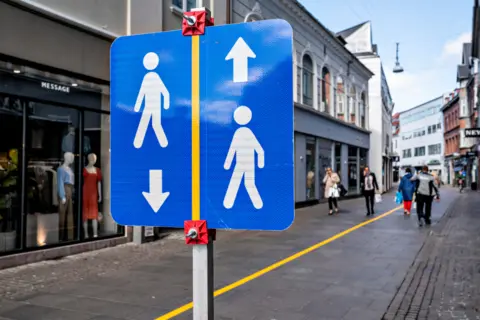 Reuters
ReutersDenmark, one of the first European countries to announce a lockdown, started to ease restrictions in mid-April, with a four-phase plan.
- Day care centres and primary schools returned on 14 April, with children attending in shifts. Children aged 12-16 returned from 18 May
- Hairdressers, beauty and massage salons and some other well-being services reopened on 20 April
- Professional sport is allowed behind closed doors; football's Super Liga returned on 28 May
- Shopping centres reopened on 11 May with social distancing
- Social gatherings were first limited to 10 people - then on 8 June that was boosted to 50 under Phase 3
- Gyms and swimming pools are also reopening under Phase 3, with social distancing
- Cafes and restaurants reopened on 18 May, with social distancing, followed by cinemas, theatres, museums and art galleries on 21 May
- Borders reopened for tourists from Norway, Iceland and Germany on 15 June - although border controls remain with Sweden

Baltic countries: The first 'travel bubble' in Europe
 Getty Images
Getty ImagesThe three Baltic states - Lithuania, Latvia and Estonia - became the first countries in Europe to allow free movement again, but initially only with each other.
From 15 May, citizens and residents could move freely across the three countries, provided they had not travelled outside the Baltic states in the past two weeks, were not infected, and not in contact with an infected person.
Those coming from elsewhere still have to self-isolate for 14 days. Estonia then said several countries would not be affected by quarantine from 1 June, including Germany, France and Austria, and the Baltic trio resumed free movement with Poland from mid-June.

Belgium: Social bubble expanded further
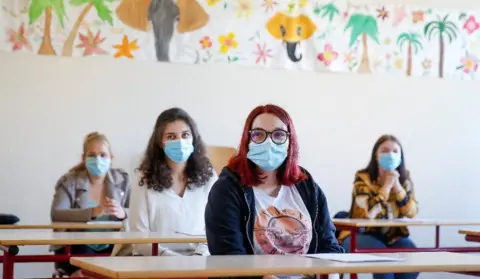 EPA
EPARestrictions are slowly being lifted in a country that has seen a high number of deaths in care homes. The country unilaterally reopened its borders to all EU and Schengen zone countries on 15 June, as well as to the UK, and on 1 July entered phase four of easing restrictions
- From 10 May, a household could receive visits from a group of up to four people. This was extended to 10 people on 8 June and grew to 15 people on 1 July
- Fabric shops reopened on 4 May, as new regulations require all Belgians aged 12 or over to wear masks on public transport
- Other shops reopened on 11 May, with strict social distancing
- Schools resumed classes from 18 May, but no more than 10 children were allowed in each classroom
- Markets, museums and zoos also reopened from 18 May, with rules for 1.5m social distancing
- Hairdressers and beauty salons reopened on 18 May
- Cafes, restaurants and sports clubs reopened from 8 June and cinemas, casinos and concerts restarted from 1 July
- From 1 July, sporting events, religious services and village fetes were allowed to have a maximum number of 200 participants or spectators indoors and 400 outside. That number doubles on 1 August.
No major events such as festivals are allowed and no nightclubs are allowed to open.

Netherlands: Hairdressers and nail bars back in business
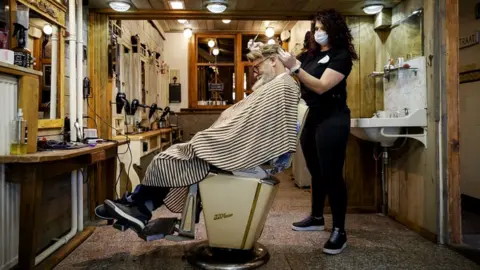 EPA
EPAThe Netherlands imposed a far less strict lockdown than next-door Belgium. Prime Minister Mark Rutte unveiled a five-phase plan for easing lockdown restrictions, which kicked in from 11 May.
A drop in cases meant the country announced plans to ease measures would be brought forward.
- Libraries are open again and hairdressers, nail bars, beauticians, masseuses and occupational therapists went back to work from 11 May
- Bars and restaurants reopened on 1 June for up to 30 guests inside and unlimited numbers outside, provided people maintain 1.5m distance. Cinemas, theatres and concert halls also reopened, subject to a 30-guest maximum, and face masks became mandatory on public transport the same day for anyone aged 13 and over
- From 1 July, there is no maximum limit on the number of people allowed inside places including shops, museums and libraries and at outside venues like zoos and theme parks - provided people stick to 1.5m social distancing. Brothels also reopened on 1 July, moved forward from planned reopening in September
- All sport including spectators is allowed as of 1 July but all group singing and chanting is banned
- Nightclubs will not reopen before 1 September
- Secondary school pupils returned to class on 2 June. Social distancing requirements for all school students ended on 1 July
- Travel advice for Dutch citizens changed on 15 June, meaning they can visit all countries within the EU or Schengen zone without restrictions. Sweden and the UK remain out of bounds except for essential travel

Austria: Weddings and outdoor sport
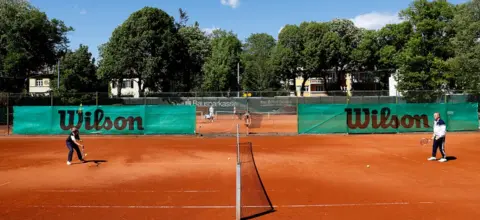 Reuters
ReutersAustria was one of the first countries to ease its lockdown. The health minister said the reopening of small shops in mid-April didn't cause a spike in cases. Borders have now been re-opened with all its neighbours, although on 1 July Austria issued a travel warning for six Balkan countries.
- Larger shops, shopping centres and hairdressers reopened in early May
- Public parks, small shops, DIY stores and garden centres have been allowed to open since 14 April
- Outdoor sport that can be socially distanced, such as tennis, golf and athletics, is now allowed
- Gatherings of up to 10 people have been allowed since the start of May
- Restaurants and cafes reopened from mid-May, while gyms, open air swimming pools, hotels and some cinemas opened at the end of May, with weddings involving up to 100 people also allowed
- Final-year school pupils returned to classes at the start of May
- From Monday 15 June, face masks are no longer required when shopping, though they remain mandatory on public transport. From 1 July, waiters do not have to wear face masks
- Austria allowed brothels to restart on 1 July, and people no longer have to stay a metre apart when playing sport

Spain: State of emergency officially ends
Spain outlined a four-stage plan on 4 May to start easing one of the strictest lockdowns in Europe, which saw children under 14 confined to their homes for six weeks.
On 1 June, Spain moved to a second phase for 70% of Spaniards, but Madrid, Barcelona and some other regions stayed under tighter phase-one restrictions.
The state of emergency officially ended on 21 June, restoring freedom of movement and reopening some borders. People must still stay 1.5 metres apart in public and wear masks on public transport and when shopping.
However, parts of northeastern Spain returned to phase two of lockdown easing in June after an outbreak of the virus among fruit pickers.
- Face masks are compulsory for anyone aged six and over in public, both inside and outside, if it isn't possible to maintain social distance
- Schools were partially reopened from 26 May. This will allow for revision classes and state exams but a full reopening is not expected until September
- From 11 May customers were able to order a beer in a terrace bar, but bars and restaurants did not fully reopen until 10 June, adhering to strict social distancing guidelines and only at 50% capacity
- Cinemas, theatres and exhibitions began reopening on 26 May, but only at 30% capacity. Outdoor concerts of up to 400 people are permitted, but with social distancing
- Spain's renowned La Liga football championship kicked off on 11 June but without spectators
- The country began lifting border controls on 21 June, and reopened its border with Portugal on 1 July

Republic of Ireland: Four phases and shops reopen
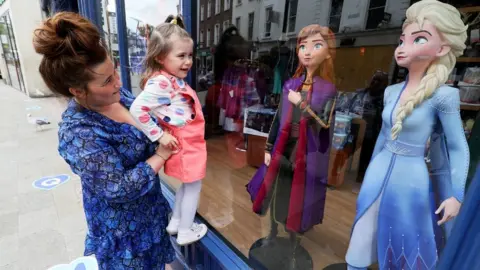 PA Media
PA MediaIreland has had a stricter lockdown than the UK, with residents only allowed to exercise within 2km (1.2 miles) of their homes. But a five-stage roadmap - later cut to four - to reopen the country started on 18 May.
- On 8 June Ireland's Phase 2 began, meaning all high street shops could reopen, while enforcing social distancing
- Phase 3 started on 29 June, and phase 4 is due to begin on 20 July.
- Limits on distances that people could travel were removed on 29 June
- Schools will remain shut until September, while outdoor workers such as construction workers and gardeners resumed activities from 18 May;
- Anyone arriving in Ireland has to go into self-isolation for 14 days
- Creches and nurseries, summer camps and youth clubs reopened under phase 3 as did cinemas, museums and music venues, but not nightclubs
- The limits on social gatherings including funerals are: groups of up to 50 indoors and 200 outdoors and outdoors while observing a 2m distance
- Team sports with spectators, indoor gyms and swimming pools restarted from 29 June
- Visitors to the UK from Ireland are exempt from the UK's two-week mandatory quarantine for international visitors, which began on 8 June

Switzerland: Museums and restaurants return
Switzerland began easing its eight-week lockdown in stages from 27 April.
- Garden centres, hairdressers and beauty salons were allowed to reopen on 27 April
- Schools, libraries, museums and non-food shops followed on 11 May, with strict distancing measures
- So too did restaurants, bars and cafes, and social distancing was reduced from 2m to 1.5m on 22 June
- Hand sanitiser is being provided at railway stations and, as cases began to rise again, the wearing of masks on public transport was made compulsory on public transport from 6 July
- A 10-day quarantine was also introduced at the start of July for countries deemed at risk
- A limit on gatherings in public spaces has been expanded to 1,000 people until 31 August
- Summer camps, cinemas and theatres reopened from 6 June along with mountain railways and cable cars

Portugal: Small, local businesses first
 Reuters
ReutersPortugal has had fewer coronavirus cases and deaths than some other south European nations.
The government announced a three-phase plan, reopening different sectors of the economy every 15 days.
However, on 22 June authorities had to reimpose restrictions in 15 neighbourhoods around Lisbon after local outbreaks. These included the return of an evening curfew and limiting gatherings to 10 people.
- Small neighbourhood shops, hairdressers, car dealerships and bookshops started opening from 4 May
- Bigger shops, restaurants, museums and coffee shops reopened from 18 May, but at reduced capacity
- Infants and some secondary school students also went back on 18 May, while primary schools and pre-schools began reopening at the start of June
- Shopping centres, cinemas and theatres were allowed to reopen at the start of June and beaches reopened on 6 June
- The border with Spain reopened on 1 July

Greece: Tourism season officially begins
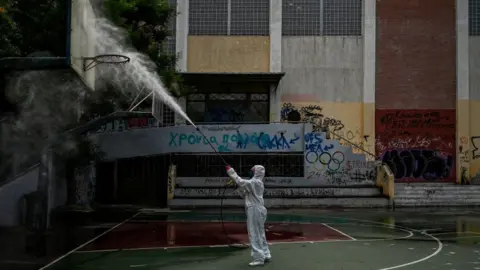 Getty Images
Getty ImagesGreece recorded its first Covid-19 case on 26 February and the government acted swiftly to impose a lockdown. On 28 April, Prime Minister Kyriakos Mitsotakis announced a relaxation of lockdown measures in the weeks ahead, with a particular focus on opening up the country for the summer.
- Beaches reopened on 4 May and Greece's tourist season officially began on 15 June, with the opening of seasonal hotels
- Travel to the islands resumed on 25 May for mainland Greeks, but not for foreign tourists; from 1 July the borders reopened and flights resumed for some international travellers
- Churches opened for individual prayer on 4 May and religious services were allowed from 17 May
- Schools reopened on 11 May for final-year students only, with special measures including students attending classes on different days; on 1 June classes resumed for primary schools and kindergartens, with 15 maximum per class
- Shops are now all able to reopen. Cafes and restaurants reopened on 25 May, but with social distancing
- Brothels reopened on 15 June with strict rules. These include card payments only, a 15-minute time limit per customer, face masks for clients and sex workers, and a list of all customers with contact information in case they need to be traced

Russia: Starting to go back to work
President Vladimir Putin announced that Russia's nationwide lockdown was being eased from 12 May, and businesses could go back to work to stop unemployment rising further. He also said it was up to individual regions to decide the best policy. But Russia's daily infection rate remains high, compared with the rest of Europe.
- Construction and industry were the first sectors to resume work, under President Putin's plan
- Large public events are still be banned, although there was a World War Two Victory Parade in Moscow on 24 June on the eve of a one-week vote on reforming the constitution
- Moscow, as the worst-hit city, kept tough restrictions until 1 June, when regular walks were allowed and parks and non-essential businesses reopened
- Then the capital lifted restrictions on travel and businesses on 9 June, with museums and libraries reopening on 16 June and gyms and restaurants reopening in the city on 23 June
- It is compulsory to wear gloves and masks in shops and on public transport in Moscow
- Schools are shut and many people are working from home

Poland: Parks and forests first to reopen
In Poland, Covid-19 numbers are lower than in many Western European countries. Although it largely escaped the worst pandemic, there was an outbreak at coal mines in the industrial heartland of Upper Silesia in early June. Poland began lifting restrictions on 20 April, when parks and forests were allowed to reopen.
- Hotels, shops, shopping centres, museums and galleries reopened on 4 May, with one customer per 15 sq m of space allowed
- Face coverings in public will remain obligatory until a vaccine is available where it is impossible to maintain a 2m distance
- Restaurants, cafes, hairdressers and beauty salons reopened from 18 May
- Primary schools reopened on 25 May, but only for the youngest children, and final-year university students were also allowed back to class
- The Ekstraklasa football championship returned on 29 May, with fans allowed back from 19 June, and maximum attendance in stadiums set at 25%
- Borders with neighbouring EU countries reopened on 13 June

Sweden: Strict measures never imposed
There was no compulsory lockdown in Sweden, unlike the measures seen elsewhere in Europe. But in line with government advice, most people took to voluntary social distancing and working from home.
- Restaurants, bars, schools and businesses remained opened. But it did ban gatherings of more than 50 people
- Sweden has recorded over 4,000 deaths, the highest per capita number in the Nordic region
- When Denmark and Norway agreed to reopen their borders to each other, from 15 June, Sweden was left out because of its high rate of infection. Just one county in Sweden was assessed by Denmark as safe to travel to in late June, Vasterbotten in the north.
Read more:

